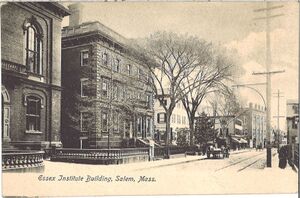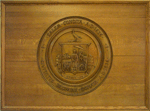Essex Institute: Difference between revisions
No edit summary |
|||
| (5 intermediate revisions by the same user not shown) | |||
| Line 1: | Line 1: | ||
The Essex Institute was formed in 1848 by the union of the Essex Historical Society and the Essex County Natural History Society. | The Essex Institute was formed in 1848 by the union of the Essex Historical Society and the Essex County Natural History Society. | ||
The massive brick and brownstone edifice at 132 Essex Street was its headquarters. It was the oldest, largest and best-known privately endowed regional historical society in the United States. | The massive brick and brownstone edifice at 132 Essex Street was its headquarters. It was the oldest, largest and best-known privately endowed regional historical society in the United States. | ||
Plummer Hall was built in 1856/57 for the Salem Athenaeum, a private library. The architect was Enoch Fuller. Reserving the upper floor for its own use, the Athenaeum rented the lower floor to the Essex Institute. Later, the Essex Institute purchased Plummer Hall in 1906 when the Athenaeum constructed a smaller, more modern building at 337 Essex Street. | |||
In the late 1860s, the Essex Institute refined its mission to the collection and presentation of regional art, history and architecture. In so doing, it transferred its natural history and archaeology collections to the East India Marine Society’s descendent organization, the Peabody Academy of Science (the “Peabody”). In turn, the Peabody, renamed for its great benefactor, the philanthropist George Peabody, transferred its historical collections to the Essex. | In the late 1860s, the Essex Institute refined its mission to the collection and presentation of regional art, history and architecture. In so doing, it transferred its natural history and archaeology collections to the East India Marine Society’s descendent organization, the Peabody Academy of Science (the “Peabody”). In turn, the Peabody, renamed for its great benefactor, the philanthropist George Peabody, transferred its historical collections to the Essex. | ||
Phillips Library was housed in Plummer Hall there for many years. | |||
[[File:Essex Institutesmall.jpg|thumb|Essex Institute (Plummer Hall)]] | [[File:Essex Institutesmall.jpg|thumb|Essex Institute (Plummer Hall)]] | ||
[[Category:Browse Index]] | [[Category:Browse Index]] | ||
==See Also== | ==See Also== | ||
*Vertical File in Salem Collection - '''Essex Institute''' | |||
*[https://catalog.noblenet.org/eg/opac/record/1507625?locg=63 The first half century of the Essex Institute] 1898 | |||
*[https://catalog.noblenet.org/eg/opac/record/2264429?locg=63 The Essex Institute : treasure house of American beginnings] Essex Institute , 1929. | |||
*[https://catalog.noblenet.org/eg/opac/record/2264429?locg=63 Architecture in Salem] B. Tolles, p. 4-5 | |||
Latest revision as of 11:43, 26 October 2023
The Essex Institute was formed in 1848 by the union of the Essex Historical Society and the Essex County Natural History Society. The massive brick and brownstone edifice at 132 Essex Street was its headquarters. It was the oldest, largest and best-known privately endowed regional historical society in the United States.
Plummer Hall was built in 1856/57 for the Salem Athenaeum, a private library. The architect was Enoch Fuller. Reserving the upper floor for its own use, the Athenaeum rented the lower floor to the Essex Institute. Later, the Essex Institute purchased Plummer Hall in 1906 when the Athenaeum constructed a smaller, more modern building at 337 Essex Street.
In the late 1860s, the Essex Institute refined its mission to the collection and presentation of regional art, history and architecture. In so doing, it transferred its natural history and archaeology collections to the East India Marine Society’s descendent organization, the Peabody Academy of Science (the “Peabody”). In turn, the Peabody, renamed for its great benefactor, the philanthropist George Peabody, transferred its historical collections to the Essex.
Phillips Library was housed in Plummer Hall there for many years.
See Also
- Vertical File in Salem Collection - Essex Institute
- The Essex Institute : treasure house of American beginnings Essex Institute , 1929.
- Architecture in Salem B. Tolles, p. 4-5

